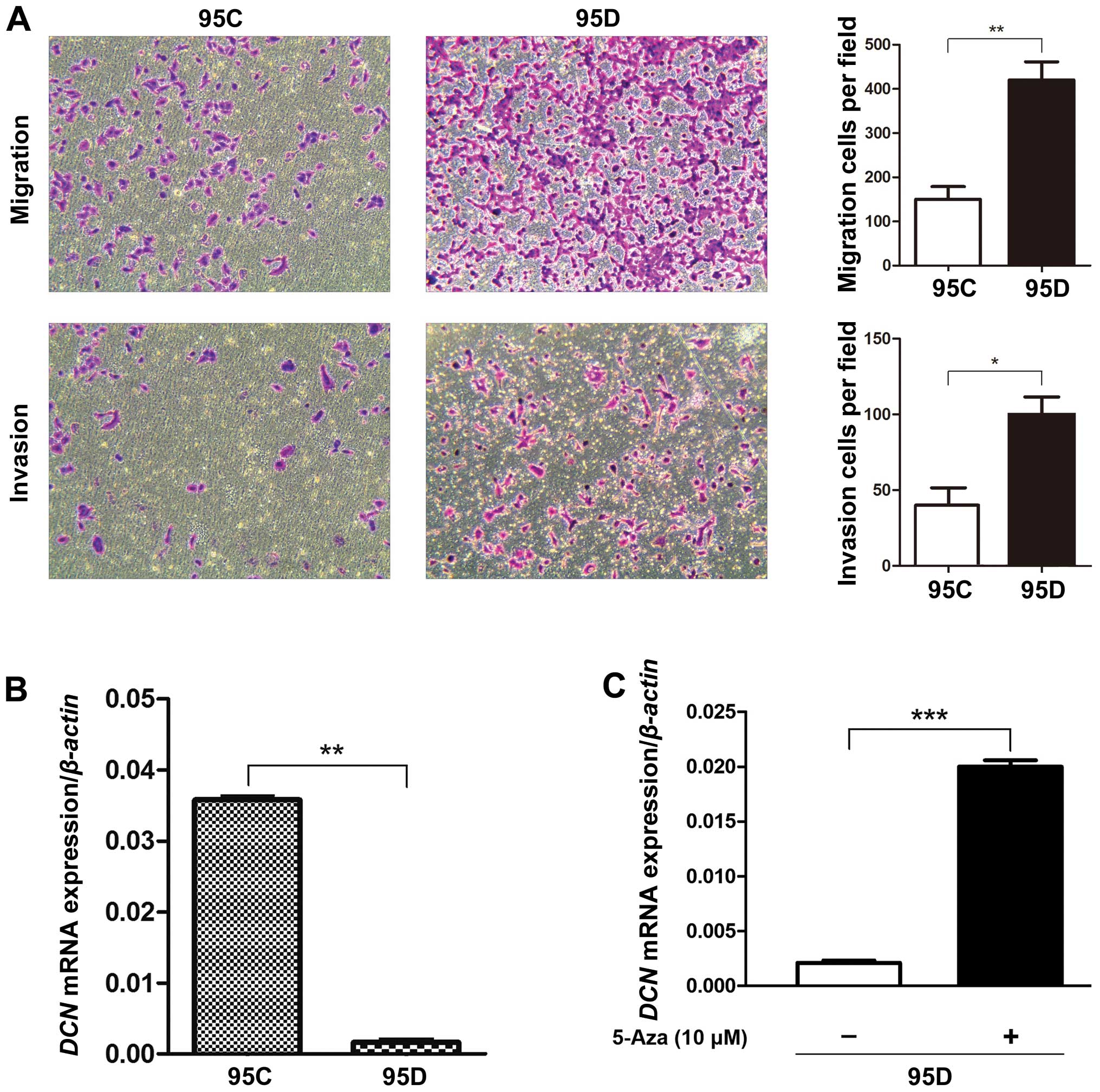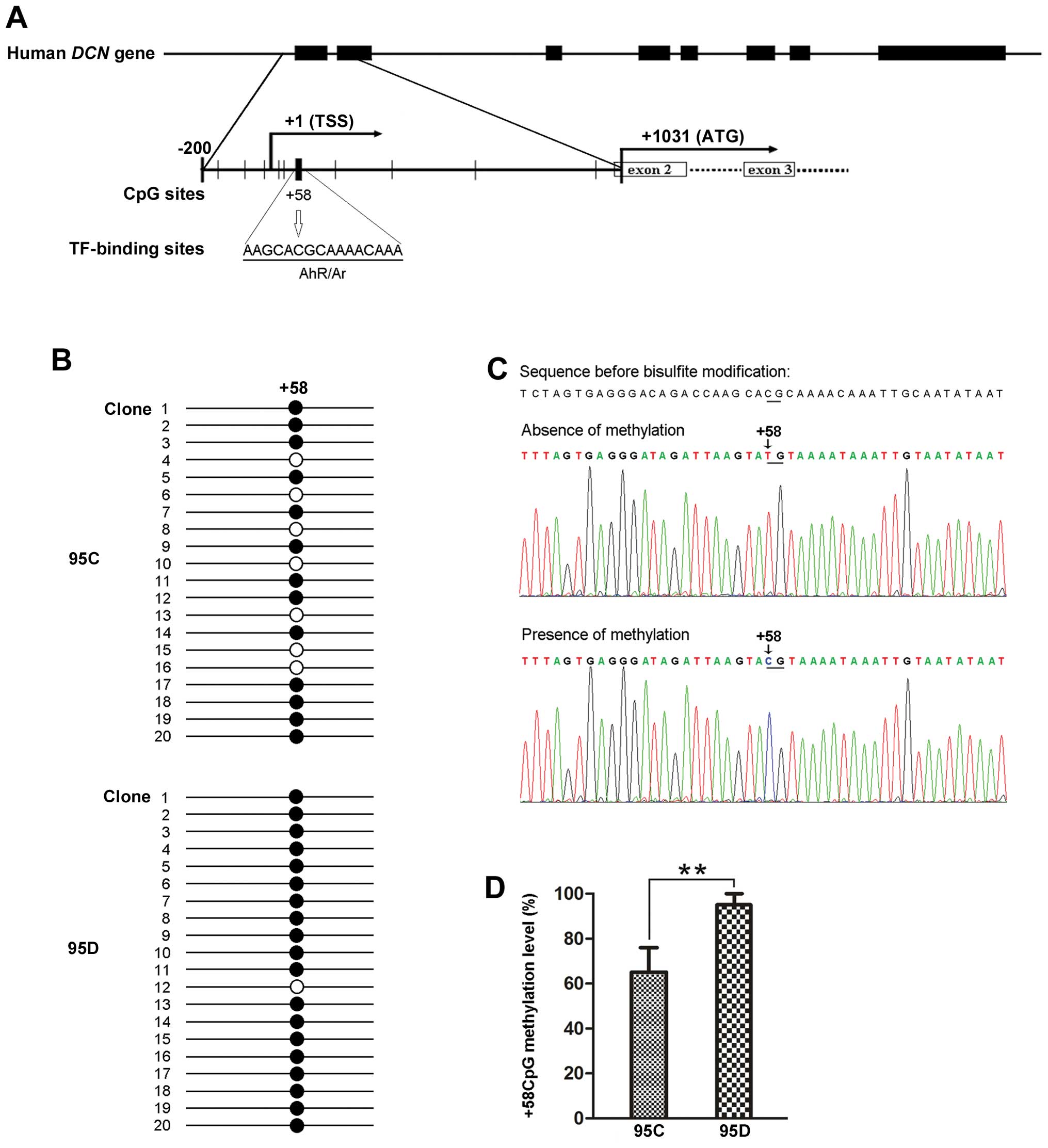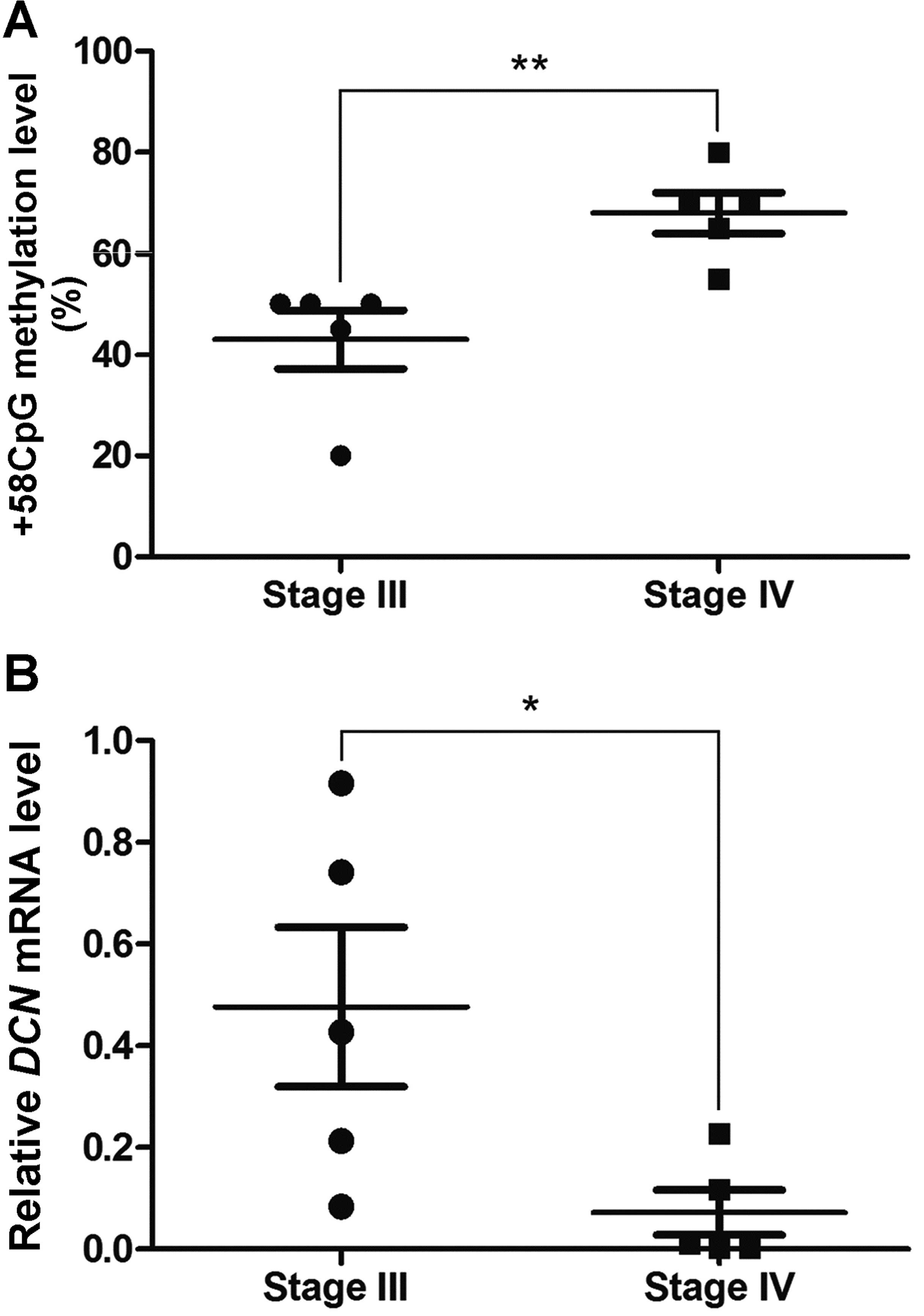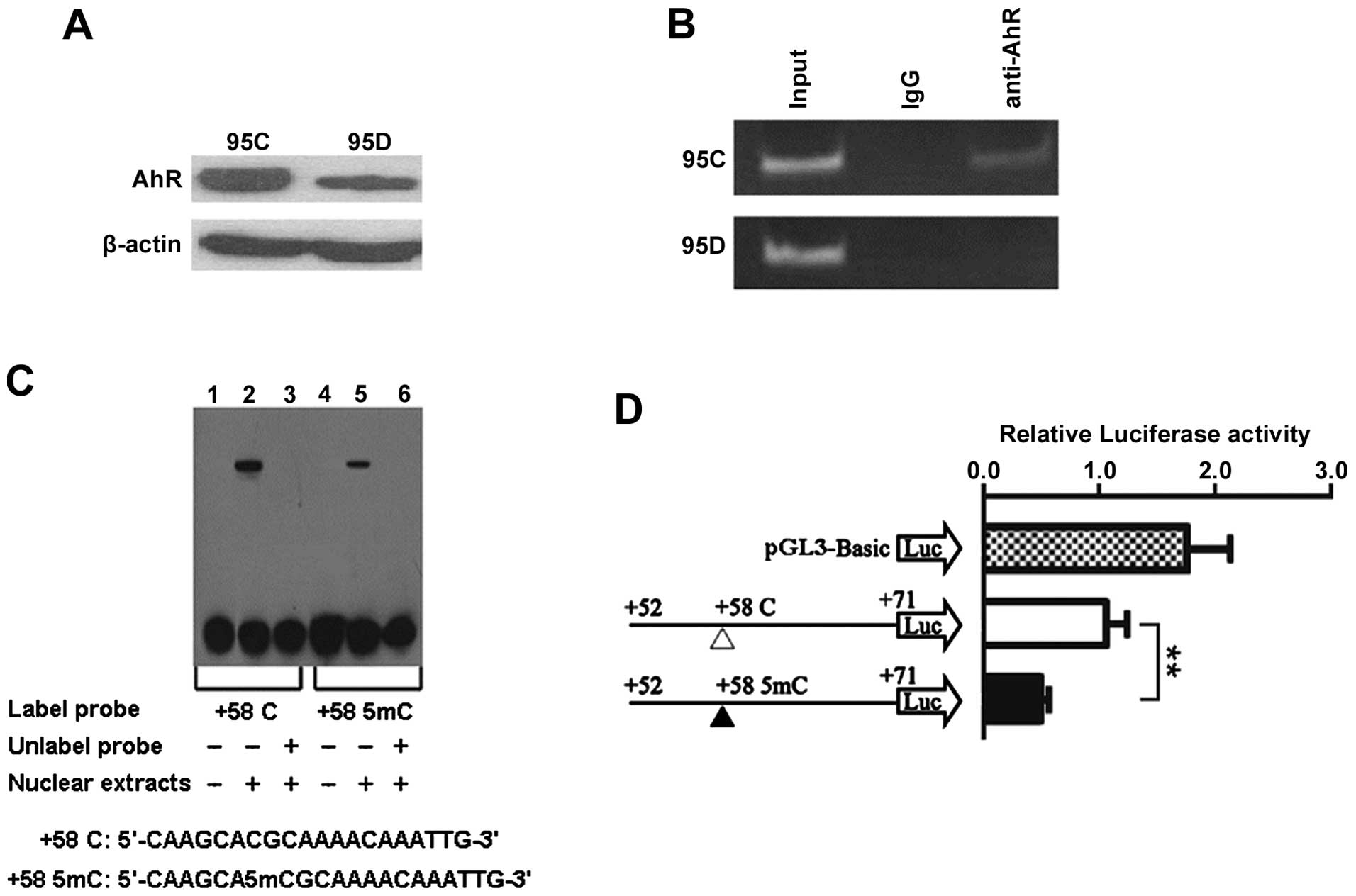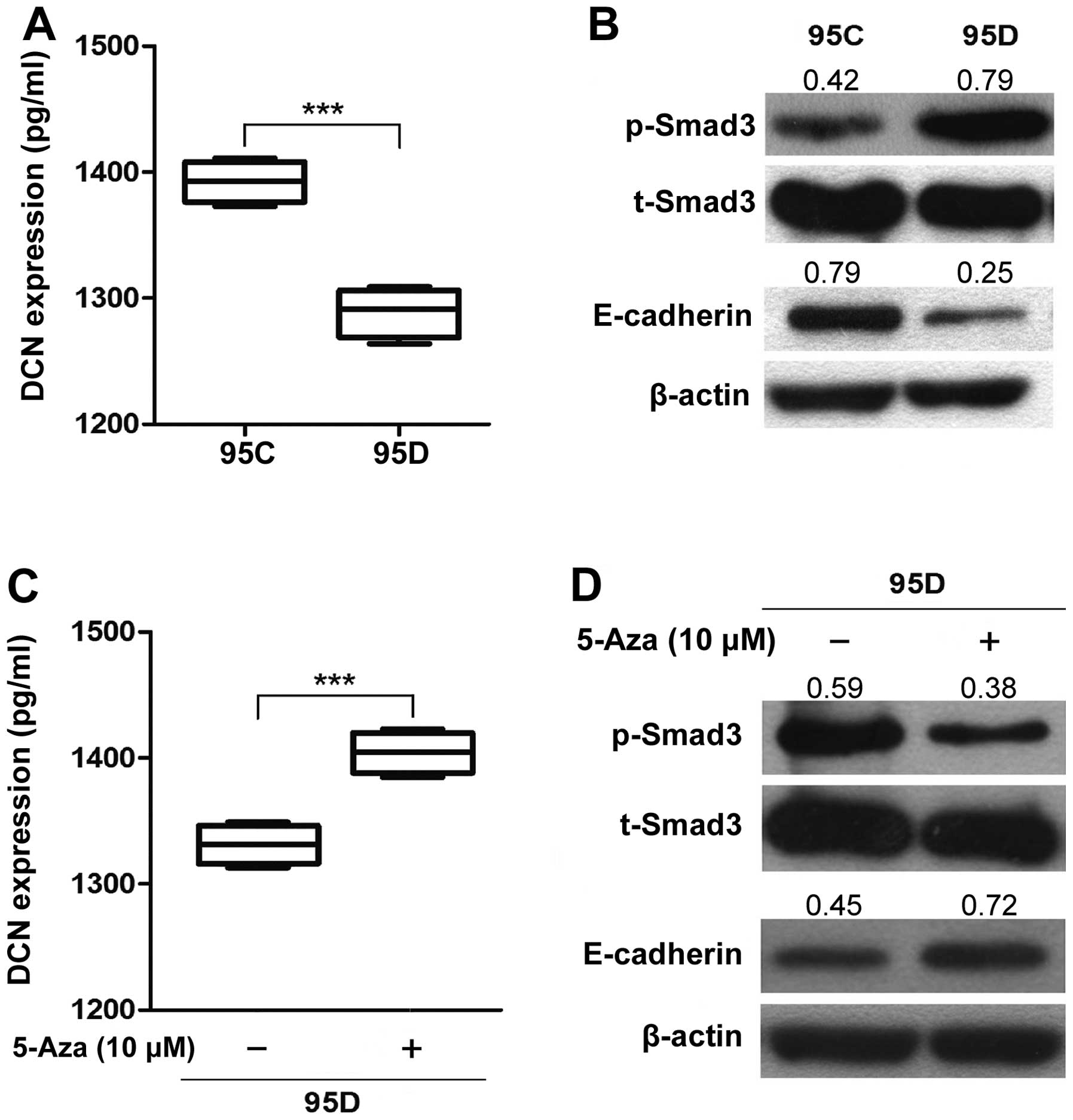Methylated +58CpG site decreases DCN mRNA expression and enhances TGF-β/Smad signaling in NSCLC cells with high metastatic potential
- Authors:
- Published online on: January 10, 2014 https://doi.org/10.3892/ijo.2014.2255
- Pages: 874-882
Abstract
Introduction
Lung cancer is the leading cause of cancer deaths in men and women worldwide (1). Non-small cell lung cancer (NSCLC) accounts for approximately 85% of all lung cancers. More than 50% of all patients diagnosed with lung cancer have advanced disease (2). Despite improvement in cancer treatment, the prognosis for NSCLC patients is still poor, with 5-year survival rate of approximately 10% (3). Since metastasis remains the cause of 90% of deaths from solid tumors (4), elucidating the mechanisms underlying lung cancer metastasis appeared to be very important.
Transforming growth factor β (TGF-β) is a ubiquitous and essential regulator of cellular and physiologic processes, such as cellular proliferation, migration, invasion and immunosurveillance (5,6). TGF-β is a double-edged sword in cancer development and progression. TGF-β signaling pathway plays a suppressive role in cell growth of early-stage tumors. On the other hand, it is recognized that metastasis of most tumor cells requires TGF-β activity, and the active TGF-β signaling became a promoter in late-stage tumors (7,8). TGF-β-induced phosphorylation of Smad3 is a vital step in the active TGF-β signaling (9) and Smad3 phosphorylation is required for lung epithelial-to-mesenchymal transition (10), which is a transition process that provides cancer cells with higher invasive and metastatic abilities (11).
Decorin (DCN) is a member of the extracellular matrix small leucine-rich proteoglycan family (12) and DCN regulates multiple processes in cancer cells (13,14). Accumulative evidence shows that DCN plays an inhibitory role in tumor growth and metastasis (15–19). This role can be played through DCN specifically binding to TGF-β and partially blocking the TGF-β signaling pathway, leading to growth suppression of distant tumors including lung cancer (20–22). Although there was evidence indicating that reduced expression of DCN was associated with lymphatic metastasis in lung cancer patients (23), the mechanisms by which the reduced DCN expression causes lung cancer metastasis appear to be elusive.
Our recent work supported the idea that DNA methylation could be epigenetically responsible for inactivation of tumor suppressor gene in NSCLC (24–26). Moreover, Doi et al and Irizarry et al suggested that DNA methylation alterations in individual CpG site may have a vital role in cancer progression (27,28). Therefore, based on the facts that DCN proximal promoter and 5′-UTR regions harbor several CpG sites and our present study showing that high-metastatic NSCLC cells presented lower expression of DCN mRNA compared with low-metastatic NSCLC cells, we hypothesized that individual CpG methylation epigenetically functions to affect DCN mRNA expression and TGF-β/Smad signaling in metastatic NSCLC cells.
Materials and methods
Cell culture and drug treatments
Low- (95C) and high-metastatic (95D) human NSCLC cell lines were purchased from Shanghai Institute of Biochemistry and Cell Biology and cultured in RPMI-1640 (Gibco-Invitrogen) with 5% fetal bovine serum (FBS, Gibco-Invitrogen) and incubated at 37°C in 5% CO2. 95C and 95D cell lines share a similar genetic background and have different tumor metastatic potential (29,30). Cell treatment with DNA demethylating agent, 5-aza-2′-deoxycitidine (5-Aza) (Sigma-Aldrich), was performed according to the protocol described previously by us (25) with some modifications. Culture medium with 5% FBS was always used in the demethylation process. The concentration of 5-Aza was 10 μM and the cells were harvested for analysis of DNA methylation on day 5. Drug treatment with 5-Aza is a currently accepted system to study effects of hypomethylation on gene expression (25).
NSCLC tissue samples
Lung carcinoma tissues were obtained after informed consent from patients with stage III or IV NSCLC in the First Affiliated Hospital of Soochow University. Stage III patients (n=5) had local lymph node metastasis (T1–4N1–2M0), while stage IV patients (n=5) had distant organ metastasis (T1–4N1–2M1). Pathological stages were determined according to the Revised TNM Staging System for Lung Cancer. NSCLC patients had received neither chemotherapy nor radiotherapy before tissue sampling. The tissue samples were snap-frozen and stored in liquid nitrogen before study. This study was approved by the Academic Advisory Board of Soochow University.
Transwell invasion and migration assays
For invasion assay, BioCoat Matrigel invasion chambers (BD Biosciences) with 8-μm pore polycarbonate membranes were pre-treated with serum-free RPMI-1640 (Gibco-Invitrogen) medium at 37°C for 2 h. After removing the medium, we added 750-μl medium with 10% FBS as chemoattractant to each lower chamber and then added 5×104 cells in 250-μl serum-free medium to each upper chamber. After 24-well plates were incubated at 37°C for 24 h, the inserts were removed and non-invasive cells on the upper surface were removed by a cotton swab. The invasive cells on the lower surface of the membrane were then fixed in 100% methanol for 15 min, air-dried, and stained with 0.1% crystal violet for 30 min. The cells were recorded with a digital camera. For migration assay, a similar procedure to the invasion assay was conducted, but omitting addition of Matrigel.
Quantitative real-time polymerase chain reaction (qRT-PCR)
Total RNA was isolated from the cells with or without treatment of 5-Aza using RNAiso Plus kit (Takara) according to the manufacturer’s protocol. Synthesis of cDNA with reverse transcriptase was performed by M-MLV First Strand kit (Invitrogen). For analysis of mRNA expression of DCN, qRT-PCR analysis was carried out using Platinum® SYBR® Green qPCR SuperMix-UDG kits (Invitrogen) according to the kit manual. Real-time PCR was performed on a Bio-Rad CFX384™ Real-Time PCR system. Primer sequences for DCN mRNA detection are as follows: 5′-CTGGTGGGCTGG CAGAGCATAA-3′ (forward), 5′-TGTTGTGTCCAGGTGG GCAGAAGT-3′ (reverse). The amplification conditions are described below: 95°C for 10 min, followed by 40 cycles of 95°C for 30 sec and 66°C for 30 sec and 72°C for 1 min. As an internal control, β-actin mRNA was measured in the same reaction conditions. DCN mRNA expression levels were calculated following normalization to β-actin mRNA levels.
In silico prediction of functional CpG sites in DCN proximal promoter and 5′-UTR regions
A 1,230-bp sequence, including DCN proximal promoter (−200 to +1) and 5′-UTR (+1 to +1,030) regions (RefSeq: NC_000012.11 and NM_133503.2), was available for CpG sites selection. Methyl Primer Express® Software v1.0 (Applied Biosystems) and TFSEARCH (http://mbs.cbrc.jp/research/db/TFSEARCH.html) were used for the prediction of the putative functional CpG sites.
Clonal bisulfite sequencing
Genomic DNA was extracted from NSCLC cells with or without treatment of 5-Aza according to standard proteinase K digestion and phenol-chloroform extraction. The genomic DNA was modified with bisulfite using EpiTect Bisulfite kit (Qiagen) and subjected to clonal bisulfite sequencing. Briefly, after the bisulfite-treated DNA was purified by Qiagen Quickspin columns, DCN 5′-UTR region containing +58CpG was amplified from bisulfite-treated DNA by PCR and cloned into pMD19-T vector (Takara). Twenty clones obtained from each of the PCR products were randomly selected and sequenced for methylation level of +58CpG site. The primers designed for the bisulfite-PCR were as follows: 5′-TGTGTGTAAAATATTGTGTAAGGTT-3′ (forward) and 5′-AATACTACTTTCTCCCTCTTCTCTA-3′ (reverse).
Western blot analysis
Cells with or without treatment of 5-Aza were lysed in RIPA buffer with protease inhibitor (Sigma-Aldrich) and phosphatase inhibitor cocktail (Sigma-Aldrich) and centrifuged; cell lysates were resuspended and denatured in SDS buffer, and then fractionated by SDS-PAGE electrophoresis. Proteins were transferred to nitrocellulose membranes (Millipore) and blocked with BSA/TBST buffer. Membranes were incubated with primary antibodies overnight before incubation with the corresponding HRP-conjugated secondary antibodies. Detection was performed using ECL kit (Pierce, Rockford, IL, USA). All experiments were performed in triplicate. Densitometry values were determined using ImageJ 1.46r software (NIH). Densitometry values for p-Smad3 level were normalized to total Smad3, while E-cadherin and AhR was normalized to β-actin. Antibodies employed in the analysis were: anti-p-Smad3 and anti-Smad3 (CST), anti-E-cadherin (Abcam), anti-AhR and anti-β-actin (Santa Cruz), and anti-mouse and anti-rabbit secondary antibodies (Santa Cruz).
Chromatin immunoprecipitation (ChIP) assay
ChIP assay was performed using EZ-ChIP™ Chromatin Immunoprecipitation kit (Upstate). Cells grown on 15-cm dishes were fixed with 1% formaldehyde for 10 min at room temperature, and the cross-linked cells were washed twice with phosphate-buffered saline (PBS), and were scrapped in PBS buffer with protease inhibitors. The cell nuclei were collected by centrifugation of 700 × g at 4°C and resuspended in SDS lysis buffer with protease inhibitors, sonicated in ice and the cross-linked DNA was sheared to 200–1,000 bp, and the insoluble material was removed by centrifugation at 13,000 x g for 10 min. Then 100 μl of the supernatant was diluted in 900 μl buffer with protease inhibitors, and incubated with Protein G Agarose for 1 h at 4°C. After brief centrifugation, 10 μl (1%) of the supernatant was saved as the Input at 4°C, and the remaining was used for the immunoprecipitation and was incubated with 5 μg anti-AhR antibody (Santa Cruz) overnight at 4°C. Rabbit IgG antibody was used as a negative control. Antibody/chromatin complexes were incubated with Protein G Agarose for 1 h at 4°C, and then Protein G Agarose-antibody/chromatin complex was collected by brief centrifugation. After washing followed by centrifugation, we eluted the complex and the Input to obtain protein-DNA complexes. De-cross-linking was performed to free DNA by incubating in NaCl, RNase A, EDTA and proteinase K, and DNA purification was conducted using spin columns. The ChIP DNA fragments were subjected to PCR, which amplified DCN 5′-UTR sequence containing +58CpG (positions +2 to +115). Specific ChIP primers used for PCR amplification were as follows: 5′-GAATAATAAGACACGCCCTGAAG-3′ (forward) and 5′-CACGTTGCTCTTACCTCTTTTAA-3′ (reverse).
Electrophoresis mobility gel shift assay (EMSA)
Nuclear extracts were prepared from NSCLC cells using the ProteoJET™ Cytoplasmic and Nuclear Protein Extraction kit (Fermentas). The cell nuclear extracts and synthetic double-stranded and 5′ biotin-labeled oligonucleotides corresponding to the DCN +58 C (unmethylated) and +58 5mC (methylated) sequences (5′-CAAGCACGCAAAACAAATTG-3′ and 5′-CAAGCA5mCGCAAAACAAATTG-3′, respectively. The binding sequences of transcriptional factors AhR/Ar (underlined) were incubated at 25°C for 20 min using the LightShift Chemiluminescent EMSA kit (Pierce). Each reaction was performed in a total volume of 20 μl containing 20 fmol labeled probe, 2 μg nuclear extract and 50 ng Poly (dI·dC). The reaction mixture was separated on 6% non-denaturing PAGE gel, and the products were transferred to positive-charged nylon membrane and then detected by stabilized streptavidin-horseradish peroxidase conjugate (Pierce). For each competition assay, 200-fold unlabeled +58 C and +58 5mC probes were added to the reaction mixture before the addition of biotin-labeled probes.
Construction of luciferase reporter plasmids containing methylated +58CpG transfection and luciferase assays
Two fragments of interest containing the unmethylated and methylated +58CpG (5′-CAAGCACGCAAAACAAATTG-3′ and 5′-CAAGCA5mCGCAAAACAAATTG-3′, respectively) were directly synthesized and then cloned into the pGL3-Basic luciferase vector (Promega). Subsequently, the constructs carrying the unmethylated or methylated +58CpG were transiently transfected into cells using Lipofectamine 2000 (Invitrogen) and Renilla pRL-TK construct (Promega) was co-transfected as a normalizing control. Twenty-four hours later, luciferase activity was measured by the Dual-Luciferase Reporter Assay kit (Promega) on a TD20/20 Luminometer (Turner Designs). Each experiment was performed in triplicate. Results are expressed as relative luciferase activities, which are obtained following normalization to Renilla luciferase activities.
Enzyme-linked immunosorbent assay (ELISA)
ELISA was performed to determine expression levels of DCN protein from cell culture supernatants using Human Decorin ELISA kit (RayBio). Cell culture supernatants were extracted and pipetted to each well according to the manufacturer’s instructions. After adding the ELISA Stop Solution to each well, we read immediately the absorbance at 450 nm on EL×800™ Microplate Reader (BioTek). Each determination was performed in triplicate.
Statistical analysis
Results are represented as the means ± standard deviations (SD) for mRNA or protein expression. Comparisons between two groups were performed with Student’s t-test for continuous variables or with χ2 test for categorical variables. Statistical differences were considered to be significant at P<0.05. All statistical analyses were performed using GraphPad Prism 5.02 software.
Results
DNA methylation is involved in DCN mRNA expression
First, we conducted transwell assay to confirm that 95D cells have higher migration and invasion abilities than 95C cells (Fig. 1A), the phenotype differences between the two cell lines are consistent with those reported previously (29,30). Thus, we examined the expression of DCN mRNA in low- (95C) and high-metastatic (95D) human NSCLC cell lines using qRT-PCR analysis, and found that DCN mRNA expression in 95D cells was lower by far than that in 95C cells (P<0.01) (Fig. 1B). After treatment of demethylating agent 5-Aza on 95D cells expressing low DCN mRNA, DCN mRNA expression was increased by ∼10-fold (P<0.001) (Fig. 1C), suggesting the involvement of DNA methylation in DCN mRNA expression.
In silico prediction of functional CpG sites
Using Methyl Primer Express® software and TFSEARCH, we identified that one putative functional CpG site at position +58 in DCN 5′-UTR, close to the transcription start site, was predicted to locate within a transcription factor AhR/Ar-binding sequence (5′-AAGCACGCAAAACAAA-3′) (Fig. 2A). Here we designate this putative functional CpG site as +58CpG. This prediction provides support for the notion that methylation of +58CpG may functionally affect DCN mRNA expression.
Methylation level of +58CpG is higher in 95D than 95C cells, and was associated with DCN mRNA expression in metastatic NSCLC
To test whether methylation level of +58CpG affects expression of DCN mRNA, we performed clonal bisulfite sequencing to compare the differences between 95C and 95D cells. As a result, we observed that the methylation level of +58CpG was significantly higher in 95D cells expressing low DCN mRNA than 95C cells expressing high DCN mRNA (95±5 vs. 65±10%, P<0.01) (Fig. 2B–D). Comparably, the results obtained in tumor tissues suggested that methylation level of +58CpG correlates inversely with DCN mRNA expression in metastatic NSCLC tissues (Fig. 3).
AhR is recruited to DCN 5′-UTR region containing +58CpG
Aryl hydrocarbon receptor (AhR) was reported to be a transcriptional activator (31,32) and +58CpG was in silico predicted to be harbored in AhR/Ar-binding site at DCN 5′-UTR region (Fig. 2A), leading us to consider the possibility that AhR can bind to DCN 5′-UTR region containing +58CpG. First, we performed western blot analysis and found that AhR was positively expressed in both cell types, and AhR expression was lower in 95D than 95C cells (Fig. 4A). Subsequently, ChIP analysis using anti-AhR antibody showed that DCN 5′-UTR sequence containing +58CpG (positions +2 to +115) was bound by AhR in 95C cells, but not in 95D cells (Fig. 4B), indicating that there is a correlation between +58CpG and AhR, and also suggesting that high methylation level of +58CpG (Fig. 2D) may be one of the mechanisms accounting for reduced recruitment of AhR to DCN 5′-UTR region in 95D cells.
Methylation of +58CpG decreases binding ability of transcriptional factors to DCN 5′-UTR region
Next, we performed EMSA to determine whether methylated +58CpG can affect the ability of binding to transcriptional factors including AhR/Ar from the nuclear extracts. As illustrated in Fig. 4C, although both the probe containing unmethylated +58CpG and the probe containing methylated +58CpG may combine with specific DNA-binding proteins from 95D cells, the unmethylated probe has stronger binding ability than the methylated probe. This effect was consistently observed in the EMSA experiments, suggesting that the methylated +58CpG can decrease the ability of binding of transcriptional factors, including AhR/Ar, to DCN 5′-UTR region.
Methylation of +58CpG significantly inhibits luciferase reporter gene transcriptional activity
To further determine whether methylation of +58CpG alters DCN transcriptional activity by de-recruiting the transcriptional activator AhR, we therefore constructed luciferase reporter vectors containing the corresponding unmethylated and methylated fragments (AhR/Ar-binding sequence) and transiently transfected them into 95D cells. As illustrated in Fig. 4D, the methylated +58CpG caused a reduction of ∼50% in transcriptional activity compared with the unmethylated +58CpG (P<0.01). Taken together with EMSA assay, the results suggest that methylation of +58CpG may repress DCN mRNA expression by diminishing the recruitment of AhR to DCN 5′-UTR region.
DCN inhibits phosphorylation of Smad3 and enhances E-cadherin expression in metastatic NSCLC cells
DCN was reported to prevent TGF-β-induced inhibition of lung morphogenesis (33), leading us to explore the effect of DCN on TGF-β/Smad signaling. Thus, we first used ELISA assay to determine the expression of DCN protein in cell culture supernatants, and found that DCN protein expression in 95D was significantly lower than that in 95C (P<0.001) (Fig. 5A). Then we used 95C and 95D cell lines to detected the level of phosphorylated Smad3 (p-Smad3), which is an indispensable downstream effector in canonical TGF-β/Smad signaling (9). At baseline, the level of p-Smad3 was higher in 95D expressing low DCN (0.79±0.07) than that in 95C expressing high DCN (0.41±0.05) (P=0.028, Fig. 5B). Correspondingly, 5-Aza treatment significantly restored expression of DCN protein in 95D cell culture supernatants (P<0.01) (Fig. 5C) and decreased the level of p-Smad3 in 95D cells (0.37±0.10 vs. 0.55±0.10; P=0.010) (Fig. 5D), suggesting that demethylation-induced restoration of DCN (Fig. 5C) antagonizes bioactive TGF-β (33), leading to a reduction in the p-Smad3 level and an inhibition of TGF-β/Smad signaling.
DCN-mediated inhibition of colorectal cancer migration is associated with E-cadherin (13,15–19,34). Here we examined expression of E-cadherin in 95D expressing low DCN and 95C expressing high DCN, and found that E-cadherin expression was significantly lower in 95D cells (0.25±0.05) than 95C cells (0.73±0.07) (P=0.016) (Fig. 5B). Correspondingly, 5-Aza treatment significantly increased expression of E-cadherin in 95D cells (0.70±0.07 vs. 0.48±0.10; P=0.013) (Fig. 5D). The results suggest that DCN may enhance expression of E-cadherin in metastatic NSCLC cells.
Discussion
In this study, we have identified the methylated +58CpG in DCN 5′-UTR associated with reduced expression of DCN mRNA in high-metastatic NSCLC cells. Our findings reveal that +58CpG methylation may be one of the mechanisms accounting for reduced recruitment of transcriptional activator AhR to DCN 5′-UTR, and suggest that this mechanism promotes TGF-β/Smad signaling by enhancing phosphorylation of Smad3, thereby downregulates E-cadherin in high-metastatic NSCLC cells.
Compelling evidence has shown that DCN contributes to inhibition of tumor growth and metastasis (13,15–19,34). Goldoni et al reported that DCN can display an anti-metastatic role in breast cancer (16). Bi et al demonstrated that DCN may act as a tumor suppressor gene (15) and mediate inhibition of colorectal cancer growth and migration (13). Among soft tissue tumor patients with recurrent or metastatic lesions, lower levels of DCN were expressed in secondary lesions than those in primary lesions (17). Decreased expression of DCN was found to be significantly associated with lymphatic metastasis of lung cancer patients (23). In the present study, we focused on low- (95C) and high-metastatic (95D) NSCLC cells, which were more genetically similar to each other and could be an ideal model for cancer metastasis (29,30), and found that DCN mRNA was significantly lower in 95D cells compared with that in 95C cells, supporting the idea that DCN was involved in metastasis of malignant tumors, including lung cancer. Additionally, demethylating drug 5-Aza restored DCN mRNA expression in 95D cells, suggesting the involvement of DNA methylation in DCN expression. Treatment with 5-Aza is a currently accepted system to study effects of demethylation on gene expression, albeit this compound is recognized to be capable of inducing other cellular effects (25).
To figure out the epigenetic mechanisms underlying reduced DCN mRNA expression in high-metastatic NSCLC cells, we examined DNA methylation level of +58CpG that was predicted to locate within AhR/Ar-binding sequence of 5′-UTR region. Based on the evidence that AhR/Ar is reported to be a transcriptional activator (31,32), our findings support the idea that +58CpG plays a role in reducing DCN mRNA expression by a methylation mechanism in high-metastatic 95D cells. More recently, DNA methylation was recognized to suppress epigenetically gene expression via preventing the binding of TF to methylated CpG dinucleotides within TF-binding sites (35–37). This is substantiated by our ChIP, EMSA and luciferase experiments, which showed that methylated +58CpG can decrease its ability of binding to AhR and lead to a reduction in transcriptional activity. The results shed light on the important role of +58CpG methylation in NSCLC metastasis, and supported the notion that individual CpG methylation plays a vital role in cancer progression (27,28).
Given that DCN can cause growth inhibition of tumor cells including NSCLC by blocking TGF-β signaling (20–22), we are inspired to evaluate the effect of DCN expression on TGF-β/Smad signaling during NSCLC progression. To reach this goal, here we examine the level of p-Smad3, which is essential for activating canonical TGF-β/Smad signaling (9), and the expression of E-cadherin, which was reported to correlate with DCN-mediated inhibition of colorectal cancer migration (13), in 95C expressing high DCN and 95D expressing low DCN. Our results suggest that DCN inhibited phosphorylation of Smad3 and enhanced E-cadherin expression in metastatic NSCLC cells. Interestingly, demethylating drug 5-Aza treatment significantly decreased the level of p-Smad3 in 95D cells, suggesting that the blocking of TGF-β/Smad signaling may be caused by demethylation-induced restoration of DCN. This is consistent with previous data that DCN can antagonize bioactive TGF-β during lung growth and differentiation (33). Moreover, demethylation-induced restoration of DCN via 5-Aza treatment led to an increased E-cadherin in 95D cells. The results support the notion that TGF-β/Smad signaling is a promoter in late-stage tumors, including NSCLC (7,8,11,38), and DCN-mediated inhibition of colorectal cancer migration is associated with E-cadherin (12–14).
In conclusion, we identified the methylated +58CpG in DCN 5′-UTR associated with reduced expression of DCN mRNA, and revealed that +58CpG methylation may be one of mechanisms accounting for reduced recruitment of transcriptional activator AhR to DCN 5′-UTR, and suggest that this mechanism promotes TGF-β/Smad signaling by enhancing phosphorylation of Smad3, thereby downregulates E-cadherin in high-metastatic NSCLC cells.
Acknowledgements
We are grateful for participation and cooperation from the patients with NSCLC. This study was supported in part by the grants from National Natural Science Foundation of China (81171894 and 81372277 to H.-T. Zhang), Program for New Century Excellent Talents in University (NCET-09-0165 to H.-T. Zhang), National Natural Science Foundation of China (81201575 to Z. Liu), Jiangsu Province’s Key Provincial Talents Program (RC2011106 to J. Zhao), ‘333’ Project of Jiangsu Province Government (to H.-T. Zhang), Soochow Scholar Project of Soochow University (to H.-T. Zhang), and Suzhou Key Laboratory for Molecular Cancer Genetics (SZS201209 to H.-T. Zhang).
References
|
Jemal A, Siegel R, Ward E, et al: Cancer statistics, 2008. CA Cancer J Clin. 58:71–96. 2008. View Article : Google Scholar | |
|
Ramsey SD, Clarke L, Kamath TV and Lubeck D: Evaluation of erlotinib in advanced non-small cell lung cancer: impact on the budget of a U.S. health insurance plan. J Manag Care Pharm. 12:472–478. 2006.PubMed/NCBI | |
|
Feng J, Zhang X, Zhu H, Wang X, Ni S and Huang J: High expression of FoxP1 is associated with improved survival in patients with non-small cell lung cancer. Am J Clin Pathol. 138:230–235. 2012. View Article : Google Scholar : PubMed/NCBI | |
|
Gupta GP and Massague J: Cancer metastasis: building a framework. Cell. 127:679–695. 2006. View Article : Google Scholar : PubMed/NCBI | |
|
Shi Y and Massague J: Mechanisms of TGF-beta signaling from cell membrane to the nucleus. Cell. 113:685–700. 2003. View Article : Google Scholar : PubMed/NCBI | |
|
Toonkel RL, Borczuk AC and Powell CA: TGF-beta signaling pathway in lung adenocarcinoma invasion. J Thorac Oncol. 5:153–157. 2010. View Article : Google Scholar : PubMed/NCBI | |
|
Akhurst RJ and Derynck R: TGF-beta signaling in cancer - a double-edged sword. Trends Cell Biol. 11:S44–S51. 2001.PubMed/NCBI | |
|
Xu Y and Pasche B: TGF-beta signaling alterations and susceptibility to colorectal cancer. Hum Mol Genet. 16(Spec No 1): R14–R20. 2007. View Article : Google Scholar : PubMed/NCBI | |
|
Liu X, Sun Y, Constantinescu S, Karam E, Weinberg R and Lodish H: Transforming growth factor beta-induced phosphorylation of Smad3 is required for growth inhibition and transcriptional induction in epithelial cells. Proc Natl Acad Sci USA. 94:10669–10674. 1997. View Article : Google Scholar : PubMed/NCBI | |
|
Velden JL, Alcorn JF, Guala AS, Badura EC and Janssen-Heininger YM: c-Jun N-terminal kinase 1 promotes transforming growth factor-beta1-induced epithelial-to-mesenchymal transition via control of linker phosphorylation and transcriptional activity of Smad3. Am J Respir Cell Mol Biol. 44:571–581. 2011. View Article : Google Scholar | |
|
Yilmaz M, Christofori G and Lehembre F: Distinct mechanisms of tumor invasion and metastasis. Trends Mol Med. 13:535–541. 2007. View Article : Google Scholar : PubMed/NCBI | |
|
Goldoni S, Owens RT, McQuillan DJ, et al: Biologically active decorin is a monomer in solution. J Biol Chem. 279:6606–6612. 2004. View Article : Google Scholar : PubMed/NCBI | |
|
Bi X, Pohl NM, Qian Z, et al: Decorin-mediated inhibition of colorectal cancer growth and migration is associated with E-cadherin in vitro and in mice. Carcinogenesis. 33:326–330. 2012. View Article : Google Scholar : PubMed/NCBI | |
|
Bi XL and Yang W: Biological functions of decorin in cancer. Chin J Cancer. 32:266–269. 2013. View Article : Google Scholar : PubMed/NCBI | |
|
Bi XL, Tong C, Dockendorff A, et al: Genetic deficiency of decorin causes intestinal tumor formation through disruption of intestinal cell maturation. Carcinogenesis. 29:1435–1440. 2008. View Article : Google Scholar | |
|
Goldoni S, Seidler DG, Heath J, et al: An antimetastatic role for decorin in breast cancer. Am J Pathol. 173:844–855. 2008. View Article : Google Scholar : PubMed/NCBI | |
|
Matsumine A, Shintani K, Kusuzaki K, et al: Expression of decorin, a small leucine-rich proteoglycan, as a prognostic factor in soft tissue tumors. J Surg Oncol. 96:411–418. 2007. View Article : Google Scholar : PubMed/NCBI | |
|
Nash MA, Deavers MT and Freedman RS: The expression of decorin in human ovarian tumors. Clin Cancer Res. 8:1754–1760. 2002.PubMed/NCBI | |
|
Reed CC, Gauldie J and Iozzo RV: Suppression of tumorigenicity by adenovirus-mediated gene transfer of decorin. Oncogene. 21:3688–3695. 2002. View Article : Google Scholar : PubMed/NCBI | |
|
Kresse H and Schonherr E: Proteoglycans of the extracellular matrix and growth control. J Cell Physiol. 189:266–274. 2001. View Article : Google Scholar : PubMed/NCBI | |
|
Tralhao JG, Schaefer L, Micegova M, et al: In vivo selective and distant killing of cancer cells, using adenovirus-mediated decorin gene transfer. FASEB J. 17:464–466. 2003.PubMed/NCBI | |
|
Yamaguchi Y, Mann DM and Ruoslahti E: Negative regulation of transforming growth factor-beta by the proteoglycan decorin. Nature. 346:281–284. 1990. View Article : Google Scholar : PubMed/NCBI | |
|
Biaoxue R, Xiguang C, Hua L, et al: Decreased expression of decorin and p57(KIP2) correlates with poor survival and lymphatic metastasis in lung cancer patients. Int J Biol Markers. 26:9–21. 2011. View Article : Google Scholar : PubMed/NCBI | |
|
Liu Z, Zhao J, Chen XF, et al: CpG island methylator phenotype involving tumor suppressor genes located on chromosome 3p in non-small cell lung cancer. Lung Cancer. 62:15–22. 2008. View Article : Google Scholar : PubMed/NCBI | |
|
Liu Z, Li W, Lei Z, et al: CpG island methylator phenotype involving chromosome 3p confers an increased risk of non-small cell lung cancer. J Thorac Oncol. 5:790–797. 2010. View Article : Google Scholar : PubMed/NCBI | |
|
Zhang HT, Chen XF, Wang MH, et al: Defective expression of transforming growth factor beta receptor type II is associated with CpG methylated promoter in primary non-small cell lung cancer. Clin Cancer Res. 10:2359–2367. 2004. View Article : Google Scholar : PubMed/NCBI | |
|
Doi A, Park IH, Wen B, et al: Differential methylation of tissue-and cancer-specific CpG island shores distinguishes human induced pluripotent stem cells, embryonic stem cells and fibroblasts. Nat Genet. 41:1350–1353. 2009. View Article : Google Scholar | |
|
Irizarry RA, Ladd-Acosta C, Wen B, et al: The human colon cancer methylome shows similar hypo- and hypermethylation at conserved tissue-specific CpG island shores. Nat Genet. 41:178–186. 2009. View Article : Google Scholar : PubMed/NCBI | |
|
Lu YL, Huang JX, Li XH, et al: Spontaneous metastasis of clonal cell subpopulations of human lung giant cell carcinoma after subcutaneous inoculation in nude mice. Chin J Oncol. 11:1–7. 1989.PubMed/NCBI | |
|
Sun W, Guo C, Meng X, et al: Differential expression of PAI-RBP1, C1orf142, and COTL1 in non-small cell lung cancer cell lines with different tumor metastatic potential. J Investig Med. 60:689–694. 2012.PubMed/NCBI | |
|
Shang Y, Myers M and Brown M: Formation of the androgen receptor transcription complex. Mol Cell. 9:601–610. 2002. View Article : Google Scholar : PubMed/NCBI | |
|
Sogawa K and Fujii-Kuriyama Y: Ah receptor, a novel ligand-activated transcription factor. J Biochem. 122:1075–1079. 1997. View Article : Google Scholar : PubMed/NCBI | |
|
Zhao J, Sime PJ, Bringas P Jr, Gauldie J and Warburton D: Adenovirus-mediated decorin gene transfer prevents TGF-beta-induced inhibition of lung morphogenesis. Am J Physiol. 277:L412–L422. 1999.PubMed/NCBI | |
|
Koninger J, Giese NA, di Mola FF, et al: Overexpressed decorin in pancreatic cancer: potential tumor growth inhibition and attenuation of chemotherapeutic action. Clin Cancer Res. 10:4776–4783. 2004. View Article : Google Scholar : PubMed/NCBI | |
|
Cairns P: Gene methylation and early detection of genitourinary cancer: the road ahead. Nat Rev Cancer. 7:531–543. 2007. View Article : Google Scholar : PubMed/NCBI | |
|
Lu F and Zhang HT: DNA methylation and nonsmall cell lung cancer. Anat Rec. 294:1787–1795. 2011. View Article : Google Scholar : PubMed/NCBI | |
|
Luczak MW and Jagodzinski PP: The role of DNA methylation in cancer development. Folia Histochem Cytobiol. 44:143–154. 2006.PubMed/NCBI | |
|
Jeon HS and Jen J: TGF-beta signaling and the role of inhibitory Smads in non-small cell lung cancer. J Thorac Oncol. 5:417–419. 2010. View Article : Google Scholar : PubMed/NCBI |



